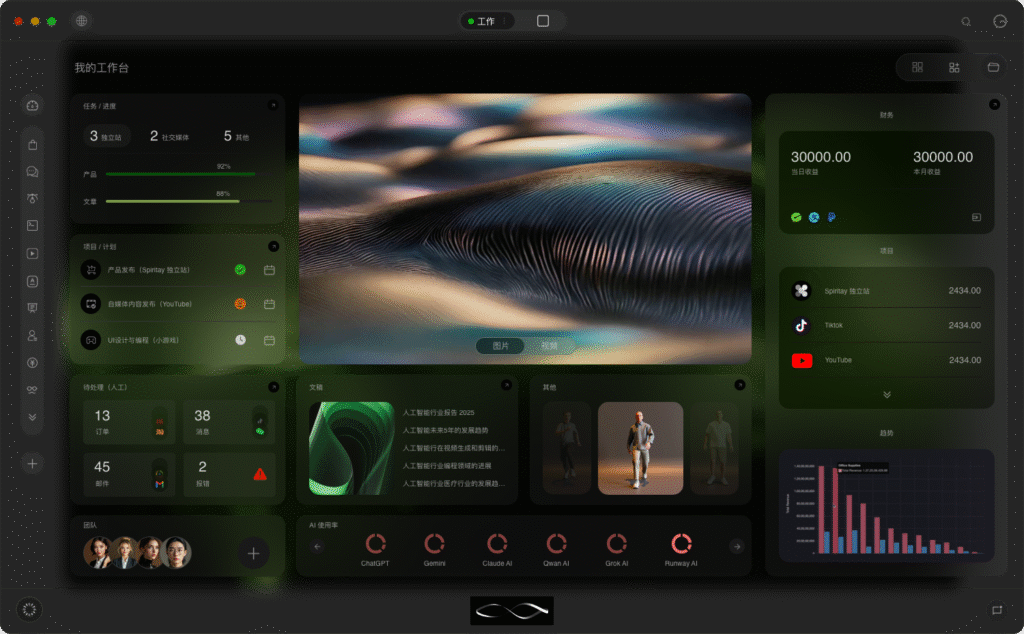Introduction: What an AI distributed OS actually solves
Imagine a digital operations center where conversational assistants, document processors, RPA bots, and analytics pipelines all coordinate like a well-drilled crew. That is the promise behind the phrase AI distributed OS: a software layer that wraps intelligence, orchestration, and governance into a cohesive runtime for automated work.
For a non-technical manager, think of it as an operating system for your organization’s AI tasks: task scheduling, device and model management, secure data access, and resilient execution. For developers, it’s a distributed control plane that combines event routing, model serving, and workflow execution with observability and policy controls.
Why this matters now
Organizations are no longer running a few isolated automations. They are building networks of agents, integrating RPA with machine learning, and streaming decisions into customer experiences. The shift from siloed scripts to networked intelligence raises new requirements: scale, observability, secure model governance, and predictable latency. A practical AI distributed OS addresses these by providing shared abstractions and operational primitives.
Core components and architecture
An effective AI distributed OS is modular but opinionated. Typical components include:

- Control plane: workflow designer, policy engine, and metadata catalog.
- Data plane: event buses, connectors to databases, message queues, and streams (e.g., Kafka, Pulsar).
- Compute plane: model serving clusters, GPU/CPU autoscaling, and task executors.
- Service mesh and networking: secure RPC, retries, and service discovery.
- Observability stack: logging, tracing, metrics, and drift detection.
- Security and governance: RBAC, auditing, model lineage, and data residency enforcement.
Architecturally, there are two dominant patterns:
- Synchronous request-response for low-latency inference and conversational agents. This is common for customer-facing flows where tail latency matters.
- Event-driven asynchronous pipelines for batched processing, document ingestion, or long-running tasks. Here, systems like Temporal, Argo Workflows, or serverless functions coordinate reliable execution.
Integration patterns
Common integration patterns include:
- API gateway + model router: route calls to different model versions or hardware profiles based on request attributes.
- Event sourcing with stream processors: transform and enrich events before they reach inference services.
- Hybrid RPA + ML pipelines: RPA captures UI-level inputs, queues them to processing services backed by models, and feeds results back to the UI bot.
Developer considerations: building blocks and trade-offs
Engineers must balance throughput, latency, cost, and operational complexity. Here are practical topics to weigh.
Model serving and inference
Decide between managed model-hosting (cloud vendor endpoints) and self-hosted servers (Kubernetes with model-server frameworks). Managed endpoints simplify updates and scaling but can be costly and restrictive for compliance. Self-hosting offers control over hardware (GPU allocation, mixed-precision inference) and custom optimizations, but increases DevOps burden.
Batching, quantization, and model sharding are levers to optimize throughput. Measure both p95/p99 tail latency and throughput (requests per second) under realistic workload profiles to choose appropriate autoscaling policies.
Orchestration and workflow control
Temporal and Argo are popular choices for durable workflow orchestration. They provide retry semantics, checkpointing, and long-running state. For highly interactive agents, a lighter-weight orchestration layer with an event mesh and ephemeral worker pools can be better for latency-sensitive tasks.
APIs and contract design
APIs in an AI distributed OS should be explicit about idempotency, versioning, and observability signals. Use asynchronous job patterns with status endpoints and webhooks for long-running operations. Include model-version headers and request tracing IDs to link front-end requests to backend model invocations.
Observability and failure modes
Monitoring must capture both system and model signals. Track hardware utilization, queue depth, request latency distribution, and error rates. Add model-health metrics: prediction distributions, confidence shifts, and data drift statistics. Common failure modes include cascade failures from overloaded model pools, stale caching, and corrupt input data pipelines.
Security, compliance, and governance
AI automation surfaces data and decision risks. Design for zero-trust between tenants or departments, encrypt data in transit and at rest, and implement fine-grained RBAC for who can deploy or update models. Maintain full model lineage and deployment audit trails to satisfy internal governance and regulators.
Be aware of prompt injection and adversarial input risks—deploy input sanitizers, sandboxing for external tool integrations, and rate limits to reduce attack surface. Privacy-preserving techniques such as differential privacy or federated learning can be considered when training on sensitive data.
Implementation playbook (step-by-step in prose)
Below is a practical sequence for adopting an AI distributed OS pattern in a mid-sized organization.
- Map use cases: inventory existing automations and classify them by latency, statefulness, and data sensitivity.
- Choose primitives: pick an event bus and a workflow engine (e.g., Kafka + Temporal) and a model hosting approach that fits compliance needs.
- Prototype one critical flow end-to-end: connect data ingestion, model inference, and an actuator (RPA or API) with a single pipeline to validate latency and error handling.
- Standardize APIs and model ops: define model metadata, versioning rules, and deployment checklists; integrate CI/CD for models and infra config.
- Instrument everything: add tracing, metrics, and alerting for both infra and model drift signals before scaling up.
- Operationalize governance: automate model audits, logging retention, and access control; set SLOs for key flows and test failover paths.
- Roll out gradually: migrate workloads in waves, using canary deployments and cost monitoring to measure ROI.
Product and market perspective
Vendors are racing to position themselves as the control plane for enterprise automation. Commercial players include cloud providers’ managed inference and workflow services, RPA vendors extending ML integrations, and specialized automation platforms. On the open-source side, projects like Ray, Kubernetes-based inference stacks, and orchestration systems provide building blocks.
Operational ROI typically comes from reduced manual effort and faster cycle times. A mid-size insurer automating claims intake and triage might report 40–70% reduction in manual processing time and a payback period under a year, depending on volume and complexity. Key ROI signals to track are human hours saved, error rates reduced, throughput improvements, and cost per inference.
Managed vs self-hosted: a short comparison
- Managed: faster to launch, integrated security updates, predictable SLAs, but potentially higher ongoing costs and less control over model privacy.
- Self-hosted: full control, lower marginal inference cost at scale, better for on-prem or air-gapped environments, but requires mature DevOps and observability practices.
Case study vignette
A logistics company combined a document OCR pipeline, an Open-source large language model for classification, and an RPA layer to auto-route invoices. They built an orchestration layer that treated each shipment invoice as a small workflow: ingest, preprocess, model-classify, human-in-loop review, and finalize. By moving from a set of ad-hoc scripts to a unified AI distributed OS approach, they reduced manual routing exceptions by 55% and lowered average processing time from 48 hours to under 6 hours. They achieved this by embracing asynchronous dispatch, autoscaled inference clusters, and a lightweight audit trail for every automated decision.
Choosing models: vendor, open-source, or hybrid
Deciding which model type to use is both technical and strategic. Commercial models often excel in raw capability and managed throughput. Open-source alternatives allow customization and local hosting. If you plan to fine-tune models on internal data or require tight data residency controls, consider adopting an Open-source large language model and pairing it with in-house serving infrastructure.
Operational signals and KPIs
When evaluating an AI distributed OS in production, monitor:
- Latency percentiles (p50/p95/p99) and tail behavior.
- Throughput and hardware utilization (GPU/CPU, memory).
- Error and retry rates; queue depth and backlog.
- Model performance metrics: precision/recall, calibration, and drift indicators.
- Cost per transaction and total cost of ownership (infrastructure, licensing, human review).
Risks and common pitfalls
Teams often fail by underestimating model drift, neglecting observability, or coupling too many responsibilities into monolithic agents. Other pitfalls include ignoring cold-starts on GPU-backed services, not planning for capacity spikes, and placing sensitive models in third-party environments without proper governance.
Future outlook
Expect the space to evolve toward standardized control planes and more composable agent frameworks. Interoperability around model metadata, standardized telemetry formats, and policy-as-code will increase. Continued progress in open-source tooling and more optimized inference runtimes will make self-hosted deployments more accessible for organizations with privacy or cost constraints.
Key Takeaways
Building an AI distributed OS is both an engineering and organizational challenge. Start small, instrument heavily, and choose the deployment model that balances speed, cost, and compliance. Blend event-driven and synchronous patterns where appropriate, and gate releases with robust governance. When implemented correctly, the payoff is significant: higher throughput, lower manual effort, clearer governance, and faster delivery of AI-driven automation such as AI virtual office automation for routine administrative work.










